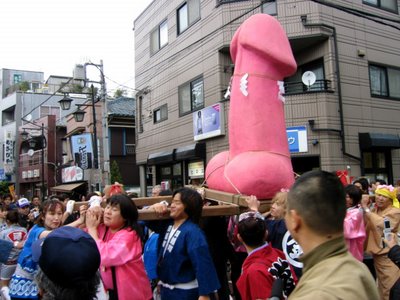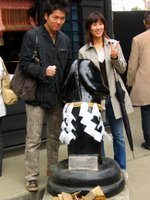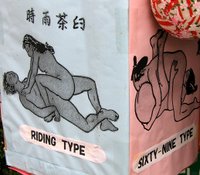 When it comes to sushi, Japan – not surprisingly – is bar none. My neighborhood is just up the subway line from the world’s greatest fish market, Tsukiji. I wasn’t making it another supermarket mystery meat bento night. I decided to revisit a sushi place private student Aiko showed me one “lesson.” This time would be different. Without a crutch, I was intruding into a salarymen stronghold feeding on the bedrock of Japanese cuisine in old town Tokyo.
When it comes to sushi, Japan – not surprisingly – is bar none. My neighborhood is just up the subway line from the world’s greatest fish market, Tsukiji. I wasn’t making it another supermarket mystery meat bento night. I decided to revisit a sushi place private student Aiko showed me one “lesson.” This time would be different. Without a crutch, I was intruding into a salarymen stronghold feeding on the bedrock of Japanese cuisine in old town Tokyo.
Approaching the storefront set gastric juices in motion. But you can’t just walk in and seat yourself. Well, you can, if you’re Japanese. I paced past the entrance to check seat availability along the two bell-shaped counters. It’s always packed. Making a U-turn after entering invites humiliation. Standing and waiting along the perimeter feels too exposed when you’re a foreigner, not to mention the only one under 40.
The glass of the double sliding door is frosted almost to the top, but standing on my toes enables reconnaissance without commitment. I already had peered in twice. Cigarette smoke blurred dark salarymen suits. I pretended to thumb text messages while waiting for someone to walk out, but hunger soon trumped insecurity.
Unlike typical establishments here, don’t expect an audible welcome upon entering, which at least doesn’t draw more attention. Other customers aren’t looking for polite service. The freshest, cheapest sushi on this side of the Sumida River keeps them coming back. I feel their gaze, but hone in on my goal – sliding into an empty stool without knocking it or anyone else over. I cringed stuffing my knees under the counter.
The grey-haired lady poured jugs of sake into customers’ overflowing glasses. I recalled her stern disposition from last time, sort of like the sushi Nazi. Apparently I wasn’t a stranger either. “I never forget a handsome face,” she said through a customer translator. Ack. I let out a breath and looked up to order. Instead, I caught people staring at me from behind beer mugs and raised chopsticks. Can he speak Japanese? Can he eat raw fish? Can he handle chopsticks? Let the games begin. In such situations, I fall back on a fail-safe recipe: draft beer. I wanted small, but ordered 1 liter. Murmurs of approval. First hurdle cleared. Next I whispered “unagi” (boiled eel) just like I had eaten when with my private student. Its mouth-watering richness makes it taste more like dessert than sushi, although it’s not raw. The sushi Nazi turned to the kitchen and yelled, “Do we have unagi today?” loud enough for everyone to overhear.
In such situations, I fall back on a fail-safe recipe: draft beer. I wanted small, but ordered 1 liter. Murmurs of approval. First hurdle cleared. Next I whispered “unagi” (boiled eel) just like I had eaten when with my private student. Its mouth-watering richness makes it taste more like dessert than sushi, although it’s not raw. The sushi Nazi turned to the kitchen and yelled, “Do we have unagi today?” loud enough for everyone to overhear.
I sensed laughter before it became audible. One observer challenged me, in English, as to why I was ordering cooked fish in a place known for its raw delights. My cheeks turned the color of a maguro slice. The lady's answer was no, followed by a sentence I couldn’t catch. The only word I recognized was anago, unagi’s salt-water cousin (conger eel). I didn’t really want it, but quickly accepted.
“Maguro,” I called out, adding the house staple of tuna to my order, which appeased any remaining detractors. I wasn’t in the clear just yet. Furtive stares anticipated how I would eat what I had spent so much effort ordering. I treated chopsticks like a surgical tool and poured less than usual soy sauce. The conger eel arrived dripping in delicious sweet eel sauce. I steered clear of the accompanying bottle filled with seasoning. Unfamiliar lids with unfamiliar contents only increased chances for embarrassment. Anago in chopstick, I raised it to my lips and stopped. Was that someone speaking to me? When you can’t understand the language, you begin to sense these things. A well-dressed gentleman in his twilight salaryman years had uttered “saisho,” or first. I knew what he meant. I had skipped a step. The eel was still undressed.
The conger eel arrived dripping in delicious sweet eel sauce. I steered clear of the accompanying bottle filled with seasoning. Unfamiliar lids with unfamiliar contents only increased chances for embarrassment. Anago in chopstick, I raised it to my lips and stopped. Was that someone speaking to me? When you can’t understand the language, you begin to sense these things. A well-dressed gentleman in his twilight salaryman years had uttered “saisho,” or first. I knew what he meant. I had skipped a step. The eel was still undressed.
I imagined drowning it in green flakes. When nothing came out, I tapped harder and the prophecy fulfilled itself. I causally smeared the sprinkles around my plate like I was seasoned expert. I looked up to find the salaryman nodding. I toasted him with a green slice of eel.
Tuesday, April 25, 2006
Sushi Place
Posted by
ジェフリー
at
10:45 AM
0
comments
![]()
Labels: food
Saturday, April 15, 2006
Welcome to Japan! (and other milestones)
That’s what the toothy man wearing a cross hanging from rosary beads said to me as the train pulled into Shinjuku station. The stop couldn’t have come sooner.
He had interrupted viewing Sleeper Cell on my iPod video to say, “Excuse me, from what country are you?” I forced a smile at “Ohhh, Big Apple!” and his hope that we (Japan and America) could be friends.
“You are handsome and clever man!” I looked away, and then tuned out a monologue professing love for Paul McCartney and the “charming” Beatles. “I want to hold your hand,” he said. I hoped he was just quoting. I tried to catch the name of the station we were bypassing. Today the express wasn’t fast enough. When I got up at Shinjuku, he shook my hand and with a big smile welcomed me to Japan. He was almost a year too late.
It’s hard to believe that today marks a full year here. Months have merged into a critical mass. I remember my first day in this then – and still now – unfamiliar setting. Lying to immigration about being a tourist. Sweating about customs uncovering neckties wrapped around resumes. The bus driver’s struggling to remove my suitcase from the belly of the airport bus. Asking for directions to the landlord’s headquarters. The elation over holding my first set of apartment keys (just like in the Fannie Mae commercial). The shock of ducking into said "apartment". Scraping old ramen out of the kitchen drain. Picking hairs out of the bathtub. Not fitting into the shower after hauling luggage along the Oedo line. Meeting Michelle for a shabu-shabu dinner in Ikebukuro. Buying the wrong train ticket to get there. Being questioned by the police on the way back.
Lying to immigration about being a tourist. Sweating about customs uncovering neckties wrapped around resumes. The bus driver’s struggling to remove my suitcase from the belly of the airport bus. Asking for directions to the landlord’s headquarters. The elation over holding my first set of apartment keys (just like in the Fannie Mae commercial). The shock of ducking into said "apartment". Scraping old ramen out of the kitchen drain. Picking hairs out of the bathtub. Not fitting into the shower after hauling luggage along the Oedo line. Meeting Michelle for a shabu-shabu dinner in Ikebukuro. Buying the wrong train ticket to get there. Being questioned by the police on the way back.
The ride hasn’t gotten easier. The everyday unfamiliarity of Japanese life is something I’ll never acclimate to, or to be honest, enjoy. Being a functional illiterate. Being hungry but not recognizing any food to order, an undertaking in itself. The discomfort created when a foreigner sits next to a local on the train or in the ramen shop. The cigarette smoke. The cramped quarters. The concrete. The crowds. The homogeneity. The dark suits. The school uniforms. The conformity. The oneness of Club Japan. The solitude of the one percent of non-Japanese.  Were it not for mischievous school kids and deliciously cheap sushi, my last blog would have been not long after the first. As it turns out, this 100th post coincides with my one-year anniversary. That’s one blog every 3.65 days, not an insignificant feat since every post is a short story that can stand alone. After finishing the school day, a second shift begins: blogging. A post requires several hours to write and edit, but adds permanence to my ever-evolving experience here. Actually, I enjoy writing more than experiencing events themselves.
Were it not for mischievous school kids and deliciously cheap sushi, my last blog would have been not long after the first. As it turns out, this 100th post coincides with my one-year anniversary. That’s one blog every 3.65 days, not an insignificant feat since every post is a short story that can stand alone. After finishing the school day, a second shift begins: blogging. A post requires several hours to write and edit, but adds permanence to my ever-evolving experience here. Actually, I enjoy writing more than experiencing events themselves.
Okay, enough nostalgia. I recently signed another one-year contract at a different school, so as soon as the blackblog about Kanokita is posted, I’ll try for another 100 stories.
Posted by
ジェフリー
at
10:30 PM
3
comments
![]()
Thursday, April 13, 2006
Changing Tactics
 Lately, Ms. Hattori has gotten smarter. Battle weary from the daily onslaught of Kanokita’s 8th graders, she has sacrificed a fellow freshman teacher to the front lines. Instead of leading class from the front, she now stands in the back and watches me sink. Why should she do the heavy lifting when the burden can be shifted?
Lately, Ms. Hattori has gotten smarter. Battle weary from the daily onslaught of Kanokita’s 8th graders, she has sacrificed a fellow freshman teacher to the front lines. Instead of leading class from the front, she now stands in the back and watches me sink. Why should she do the heavy lifting when the burden can be shifted?
I waited for her usual shouts to begin class, but they never came. I stared at her, and she stared back. So now I’m expected to take the reins, which were slipping by the second as students picked up on the breakdown in command.
I made the class repeat the greeting because instead of responding, “I’m fine thank you, and you?” they echoed the question, “How are you?” Today’s lesson plan featured an unseasonable dialogue about Thanksgiving Day. I repeated the model reading, but no matter what the month, these students aren’t listening.
From the back Ms. Hattori cried, “One more time,” which became seven more times. A few mouths moved, but were inaudible because the gang of four was concocting trouble.
Birthmark boy is the ringleader, but he gets a little help from a girl with pale skin whose attitude turns mine red. Neither had a book open, unless you counted her journal filled with mini photo machine stickers and magazine cutouts of fashionable J-teen icons.  Before class, birthmark boy invaded her privacy and introduced me to this revealing slice of middle school girl life. Hours (of class time) are spent coloring pages with thick Poca markers and gluing in small photos. It’s an illustrated diary of friends, friends turned enemies (blackened out faces), material desires (cell phones, clothing) and their concept of beauty.
Before class, birthmark boy invaded her privacy and introduced me to this revealing slice of middle school girl life. Hours (of class time) are spent coloring pages with thick Poca markers and gluing in small photos. It’s an illustrated diary of friends, friends turned enemies (blackened out faces), material desires (cell phones, clothing) and their concept of beauty.
As I thumbed through the book, I got slapped on the head. Its owner had returned was none too pleased. I shifted attention to a boy with a crew cut (usually an indicator of trouble) squeezing swirls of Elmer’s glue. It looked like marshmallows had melted onto the desktop. As I approached, he glanced up to say “petting.” He wasn’t talking about his dog. He flashed a vulgar gesture and repeated himself while pointing at journal girl. Maybe it’s a good thing she can’t understand English.
“Where’s your book, kid?”
“At home,” he said, his lips curving upward. “Heavy petting!” he then exclaimed.
I kept a straight face. Now where did he learn that? In a weak moment months ago, I taught Me Too Pants-Dropper boy the same phrase after he, too, said “petting.” I’m sure it was the end of a long day, and I thought it would be harmless. I mean, these kids use “good morning” as an after lunch greeting.
I tried not wasting much time with the gang of four because several students in the front were actually making an effort; however, the gang distracted everyone. Glue boy tossed a button from his uniform and a battery at birthmark boy. Tired of mild threats to encourage attention, I marched over, confiscated the items and threw them out the third floor window.
I should have tossed out the glue. After joking in Japanese that I wanted to drink it, glue boy uncapped the bottle and began squeezing – above his open mouth. Nothing came out. He squeezed harder.
「ばか! ばか!」 I warned “stupid.” Curious to see how far he went, I didn’t intervene. Even Ms. Hattori was watching after having migrated to the board to write some sentences.
The glue oozed out like a string elongating with gravity. And then it snapped. I was hoping for down the throat, but it missed and pooled on his nose.
“Told you, stupid,” I chimed above his cries for a tissue. Shouldering teaching responsibilities here makes it tough to get a handle on class. Not even if you super glued one on.
Posted by
ジェフリー
at
10:30 AM
0
comments
![]()
Tuesday, April 11, 2006
Extra, Extra
 read all about it. I’m pleased to announce my biggest freelance assignment to date, this week’s cover feature for Metropolis magazine, the most circulated English language magazine in Japan. It took me more than a month to research, write and revise.
read all about it. I’m pleased to announce my biggest freelance assignment to date, this week’s cover feature for Metropolis magazine, the most circulated English language magazine in Japan. It took me more than a month to research, write and revise.
Click here to read about Tokyo's less visited museums. I also took the sculptural photograph for the cover and those that accompany with the story.
Posted by
ジェフリー
at
8:50 AM
0
comments
![]()
Labels: Tokyo
Friday, April 07, 2006
Loosing That Loving Feeling
It was January, my first week back after New Year’s break. I had missed the childish camaraderie, and was even looking forward to defending the privacy of my parts on a daily basis. The last update on the mischievous nuts at Kanokita Junior High was in October. I’ve been taking careful notes of their behavior since then. By now I’ve finished up at my three other schools, so the focus of the blog will shift to these bundles of trouble doing what they do best – causing it.
“Mr. Mochizuki, how are things here at Kanokita this New Year?” I asked, fishing for gossip.
“Oh, same as usual. Not in particular,” he said showing off his front teeth from behind oversized glasses. That smile always gave me the willies.
Two more days back in session would be enough to erode Mr. Mochizuki’s veneer of winter recess relaxation to the point of disillusionment: “Mr. Jef, I no like this class. Why am I appointed this school?” he suddenly complained before class. “To tell you the truth, I don’t want to come to this place. There are very bad students, maybe the worst in Tokyo.” Although shocked by his candid confessions to a younger and contracted employee, he had a point.
The honeymoon period’s over. I dragged my feet up the stairs to class with Mr. Hirogashi, a young teacher who spent December break in Hawaii on his honeymoon. Regarding the three other schools I rotate among, he asked, “Do you notice a difference between this school and the others?”
I nearly laughed out loud, but realized he was in fact quite serious. He’s fixed at one school, and sounded like he was hoping to gain insight into the outside world populated with better disciplined students.
Perhaps he’s longing for the past. After all, he met his bride while teaching in another ward of Tokyo; however, Japanese school rules stipulate that a husband and wife cannot teach in the same ward, much less the same school. So he designated himself for reassignment, which after half a year at this school must mean he’s filed divorce papers just to get his old job back.
Blood-curling screams echoed into the stairwell from an undisclosed location. It could have been from upstairs or downstairs – maybe from both. Something then crashed to the floor. Usually it’s loud and metallic, but the dull thuds worry me most. Mr. Hirogashi filtered out these background noises.
Students at two of my other three schools were angels compared to Kanokita kids. I didn’t want honesty to burst his already bruised bubble. Morale in the teacher’s room was low enough.
“Well, the 7th graders aren’t so bad,” I said with a positive spin. Actually, Omiyada’s, led by the inept Mr. Nishono, acted worse. Kanokita’s 8th and 9th graders, however, were the bottom of the behavioral barrel.
“I think this school is like a jail,” he said as we climbed passed 8th grade classrooms on the third floor – ground zero for disobedience. His analogy was faulty. Although inmates are also bad apples, and as a matter of law must remain on the premises, a jail enforces order through authoritative guards. Kanokita is more like a game preserve where wild beasts roam free in a loosely patrolled area. There are some rangers, but not enough to be effective guardians.
At the top of the stairwell on the fourth floor, we turned right instead of left. “Oh no, no, no…not this class,” I grumbled to myself. There’s only one room at this end of the hall. It’s the class with the boy with the huge birthmark on his chin whose standard greeting is, “Oh Jefu! Son of a bitch!”
There were eleven students today, but they still outnumbered two teachers. Four girls in the front row were throwing pen cases (one labeled “Bump of Chicken,” a popular band) at one another or using textbooks to inflict head trauma. The boys behind them sketched their own variations of manga characters from an illustrated masterlist.
Efforts to overlay the worksheet on top of their drawings were brushed away. When Mr. Hirogashi then tried removing the drawings, a student yelled and ripped the worksheet in half. Mr. Hirogashi acquiesced.
The girls in the back of the room were hopeless. I knew from past experience that I’d be wasting my energy. One sat on the windowsill staring into space. One foot was planted on her seat while the other leg rested across her desk. At least she looked comfortable. Beside her, a friend craned her neck out the window to report on the boys P.E. soccer game.
Two girls glanced up from writing letters in multi-colored ink. They welcomed talking to me (in Japanese), but one preferred listening. At first I thought she had a new earring, but then spotted an earphone concealed beneath her long black hair. My face lit up, and she begged me to keep quiet. I just smiled and returned to the front of the room to survey the scene from a macro level. Finely fashioned paper airplanes crisscross flight paths in the back of the room.
Except for pretending to arrange to go to a Beyonce concert with a boy who practiced English five hours a day over winter vacation, classes were an exercise in futility. The students don’t care. There’s nothing stopping them from showing it. And there’s nothing I can do except witness the chaos unfold.
Posted by
ジェフリー
at
12:10 PM
0
comments
![]()
Sunday, April 02, 2006
Penis Festival
 Japanese schoolboys’ asking about my American body parts or inappropriately touching them has been well documented on this blog (with further outrages to come). But now I have proof that the problem isn’t me. It’s them – their repressed culture. Immaturity hit a new low yesterday in Kawasaki at the Kanamara Matsuri, or Festival of the Steel Phallus.
Japanese schoolboys’ asking about my American body parts or inappropriately touching them has been well documented on this blog (with further outrages to come). But now I have proof that the problem isn’t me. It’s them – their repressed culture. Immaturity hit a new low yesterday in Kawasaki at the Kanamara Matsuri, or Festival of the Steel Phallus.
With its origins in the Edo era, this festival is held at a shrine sprouting several smooth mushroom-headed sculptures. The festival coincides with the cherry blossoms when Kawasaki women used to pray to ward off syphilis.
The event attracted more gawking foreigners than Japanese. Penis paraphernalia and themed sweets were available, and photo-ops were aplenty. The highlight was when a mother and her baby (not the one below) slid off the wooden shaft and tumbled to the dirt.
You know what a picture’s worth; I’m not going to waste my breath.












Posted by
ジェフリー
at
8:30 AM
2
comments
![]()
Labels: festivals


